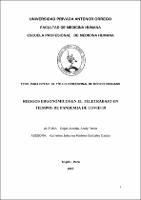Mostrar el registro sencillo del ítem
Riesgos ergonómicos en el teletrabajo en tiempos de pandemia de COVID-19
| dc.contributor.advisor | Bardales Castro, Katherine Johanna Marlene | |
| dc.contributor.author | Rojas Aranda, Analy Rocío | |
| dc.creator | Rojas Aranda, Analy Rocío | |
| dc.date.accessioned | 2020-11-25T00:38:57Z | |
| dc.date.available | 2020-11-25T00:38:57Z | |
| dc.date.issued | 2020 | |
| dc.identifier.uri | https://hdl.handle.net/20.500.12759/6826 | |
| dc.description.abstract | La pandemia de COVID-19 condicionó el distanciamiento social que, a su vez, motivó el ejercicio del teletrabajo, con subsecuentes riesgos. Objetivo: Describir los riesgos ergonómicos en el teletrabajo como parte de la situación actual. Material y métodos: Documentación y revisión de información nacional e internacional obtenida y descargada de motores de búsqueda en línea, según tesauros en ciencias de la salud. Hallazgos: Se observa que la pandemia por COVID-19 puede ocasionar consecuencias en el bienestar emocional y, al condicionar el teletrabajo, pueden originarse consecuencias físicas en el trabajador, generalmente trastornos musculo esqueléticos, estudiados en la salud ocupacional, por lo que es importante identificar los riesgos ergonómicos. Los riesgos ergonómicos documentados se refieren a posturas forzadas, movimientos repetitivos y condiciones del medio ambiente laboral. Estos diferentes grupos de riesgo encuentran recomendaciones en la literatura científica para evitarlos. Conclusión: el conocimiento de los riesgos ergonómicos es trascendental en busca del bienestar del teletrabajador. | es_PE |
| dc.description.abstract | The COVID-19 pandemic has conditioned social distancing and this, in turn, has motivated teleworking, with subsequent risks. Objective: to describe ergonomic risks in teleworking, as part of the current situation. Material and Methods: documentation and review of national and international information obtained and downloaded from online search engines, according to thesaurus in health sciences. Findings: It is observed that the COVID-19 Pandemic can cause consequences on emotional well-being and, by conditioning teleworking, physical consequences may arise in the worker, mainly musculoskeletal disorders, studied in occupational health, so it is important to identify ergonomic risks. The documented ergonomic risks refer to forced postures, repetitive movements and the conditions of the working environment. These different risk groups, in turn, find recommendations in the scientific literature to avoid them. Conclusion: knowledge of ergonomic risks is trascendental to ensure teleworker´s well-being. | en_US |
| dc.description.uri | Tesis | es_PE |
| dc.format | application/pdf | es_PE |
| dc.language.iso | spa | es_PE |
| dc.publisher | Universidad Privada Antenor Orrego - UPAO | es_PE |
| dc.relation.ispartofseries | T_MED_2884 | |
| dc.rights | info:eu-repo/semantics/openAccess | es_PE |
| dc.source | Universidad Privada Antenor Orrego | es_PE |
| dc.source | Repositorio Institucional - UPAO | es_PE |
| dc.subject | Ergonomía | es_PE |
| dc.subject | Riesgo | es_PE |
| dc.subject | Salud laboral | es_PE |
| dc.subject | Trabajo | es_PE |
| dc.subject | Coronavirus | es_PE |
| dc.subject | Pandemias | es_PE |
| dc.title | Riesgos ergonómicos en el teletrabajo en tiempos de pandemia de COVID-19 | es_PE |
| dc.type | info:eu-repo/semantics/bachelorThesis | es_PE |
| thesis.degree.grantor | Universidad Privada Antenor Orrego. Facultad de Medicina Humana | es_PE |
| thesis.degree.name | Médico Cirujano | es_PE |
| thesis.degree.discipline | Medicina Humana | es_PE |
| dc.subject.ocde | http://purl.org/pe-repo/ocde/ford#3.02.27 | es_PE |
| renati.author.dni | 43783970 | |
| renati.type | http://purl.org/pe-repo/renati/type#tesis | es_PE |
| renati.level | http://purl.org/pe-repo/renati/nivel#tituloProfesional | es_PE |
| renati.discipline | 912016 | es_PE |
| dc.publisher.country | PE | es_PE |
Ficheros en el ítem
Este ítem aparece en la(s) siguiente(s) colección(es)
-
Medicina Humana [2774]

